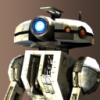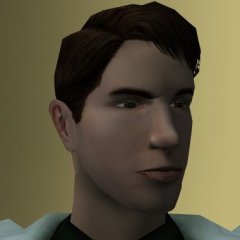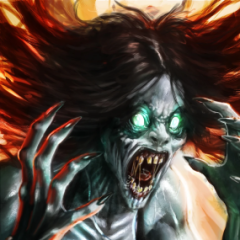-
Content Count
26 -
Joined
-
Last visited
Community Reputation
15 Jedi PadawanAbout onderduiker
-
Rank
Jedi Apprentice
Profile Information
-
Gender
Not Telling
Recent Profile Visitors
4,781 profile views
-
In the second game, bonuses to the same attribute (Strength, Dexterity, Constitution, Intelligence, Wisdom or Charisma) from items and their upgrades do not stack; only the highest value has any effect. This is most obvious with lightsaber power crystals, but it can also be seen with some armors and their upgrades. This lack of stacking could be in the first game as well. For example, the Heavy Exoskeleton has Constitution: +1 and Strength: +2, and on the Upgrade Bench screen the description for Armor Reinforcement reads Special Properties: Attribute Bonus: Constitution, +3 and Attribute Bonus: Strength, +3. However, once upgraded the Heavy Exoskeleton has Constitution: +3 and Strength: +3, not Constitution: +4 and Strength: +5.
-
StellarExile started following onderduiker
-
Mellowtron11 started following onderduiker
-
All I know so far is that it does not work the same way in the second game as it did in the first, and multiplier set seems to affect experience received (different for two enemies with Challenge Rating 5 but Set 1 and 4), which suggests the crmod column of autobalance.2da has some effect. Experience received doesn't necessarily change with each level increase, although for three test subjects in sets 1-3 it increased from 100 XP at level 1 until it was always 300 XP beyond a certain point, and for two in sets 4-5 it increased and then decreased until it was always 300 XP beyond a certain point: Set 1: Level 33 and onward (Challenge Rating 5) Set 2: Level 32 and onward (Challenge Rating 1) Set 3: Level 27 and onward (Challenge Rating 16) Set 4: Level 31 and onward (Challenge Rating 5), minimum 150 XP at level 1 and maximum 450 XP at levels 27-29 Set 5: Level 31 and onward (Challenge Rating 20), minimum 250 XP at level 1 and maximum 675 XP at levels 15-26
- 1 reply
-
- 1
-

-
Belated thanks for posting this, as it really helped me work out how the autobalance system works for enemy stats. I've collected data for enemies in each of the five sets for levels 1-50 when compiling information for the recently created Autobalance page of StrategyWiki's Star Wars Knights of the Old Republic II: The Sith Lords guide. While the calculations on that page match all values I found empirically, I doubt they're the actual functions used since it seems more likely they'd always round down or truncate values, and that they would use the same function for all five sets: if you, or someone else reading this who's more knowledgeable or mathematically inclined than I am, can see a common function or calculation where mine currently differ, please let me know. I gathered data from the following enemies, viewing values logged in the Combat section of the Journal's Messages Log, and character templates using KotOR Tool (which set they belonged to was determined by the value displayed in the Multiplier Set field of the Advanced tab): Set 1: Sith Commando (n_sithcmndo001.utc) in Trayus Crescent (905MAL_s.rim) Set 2: Sith Assassin (g_sithass002.utc) in Trayus Crescent (905MAL_s.rim) Set 3: Sith Marauder (g_darkjedi007.utc) in Trayus Crescent (905MAL_s.rim) Set 4: Lightsaber Floating (n_lightsaber001-003.utc) in Trayus Core (904MAL_s.rim) Set 4: Darth Sion (n_darthsion002.utc) in Trayus Academy (903MAL_s.rim), only for levels 16-50 Set 5: Greater Storm Beast (c_stormbeast004.utc) in Malachor Depths (902MAL_s.rim) Set 5: Darth Traya (n_darthtraya001.utc) in Trayus Core (904MAL_s.rim), only for levels 30-50 Level For all sets, level = class level(s) + rounddown(main level * 0.75) - 1: since enemies normally only have class level 1, this normally simplifies to rounddown(main level * 0.75). The easiest way to determine enemy level is to edit the savegame of a level 1 character to add Force Resistance or Immunity beforehand, then warp to the location of a Force user and activate it before engaging, and view the level logged when enemy Force powers roll against it afterward. Level can also be derived from feat or Force power DC, if you know everything else that contributes to it (like attribute bonuses, which can be found in the character template). Vitality Base Vitality multiplier can be calculated as follows: Sets 1-3: max(rounddown((main lvl + 1) * 0.65) - 1; 1) Set 4: max(round(main level * 0.7) – 1; 1) Set 5: max(round(main level * 0.8) – 1; 1) I doubt these are all the actual functions used, but their output corresponds to all the empirical data collected. Maximum Vitality was normally determined using Kill: if two failed saves killed, then this equaled damage inflicted every 2 seconds times 6 (since 1/6 * 3 * 2 = 1). Otherwise, Force powers or grenades with set damage can be used, and a character will normally inflict 1 damage with unarmed attacks after editing to set Strength to 3 and remove Unarmed Specialist feats, or anything else that would increase damage. For enemies, the maximum Vitality calculation can be simplified to (base * multiplier) + (level * (CON + Toughness)): HitDie(classes.2da)/Levelup only seems to be added for your character and party members. All my normal test subjects only had class level 1 (so no level ups), but I'd found a Cannok (c_cannok01.utc) in the Restoration Zone (231TEL_s.rim) that was a level 4 Minion in set 3 with 190 Vitality at level 10: Base Vitality: 30 Multiplier: 6 = max(rounddown((10 + 1) * 0.65) - 1; 1) Level: 10 = 4 + rounddown(10 * 0.75) - 1 CON: +1 = (12 Constitution - 10) / 2 Maximum Vitality: 190 = (30 * 6) + (10 * 1) Hitdie for Minion in classes.2da is 10, but even though the Cannok was level 4 this didn't affect its maximum Vitality (unless I've calculated incorrectly). Defense Set 1: rounddown(main * 0.6) Set 2: roundup(main * 0.7) - 1 Set 3: rounddown(main * 0.8) Set 4: roundup(main * 0.9) - 1 Set 5: main level Again, I doubt these are all the actual functions used, but their output corresponds to all the empirical data collected. This bonus is added to class bonus in the Defense Breakdown logged, so for classes that receive a bonus at level 1 (Scoundrel and Droid classes, Jedi and Prestige classes), 2 should be subtracted from the displayed value to determine the autobalance bonus. Attack Sets 1-2: roundup(main level * 0.9) - 1 Set 3: roundup(main level * 0.95) - 1 Set 4: main level Set 5: rounddown(main level * 1.1) Yet again, I doubt these are all the actual functions used, but their output corresponds to all the empirical data collected. This bonus is added to base in the Attack Breakdown logged, so class level(s) should be subtracted from the displayed value to determine the autobalance bonus. The previously mentioned Cannok in the Restoration Zone that was a level 4 Minion in set 3 had base 13 at level 10, and 4 + roundup(10 * 0.95) - 1 = 13. Damage Base damage multiplier can be calculated as follows: Sets 1-5: max(roundup((main level - 1) * damagemult); 1) The output from this function corresponded to all the empirical data collected, while rounddown((main level - 1) * damagemult) + 1 did likewise in all but one case, at level 41 for set 5 (base damage multiplier was still 7, not 8, for both the Greater Storm Beast (base 10-60) and Darth Traya (base 2-20): obviously, as the only exception I checked this multiple times): interestingly, this is the only level at which the output is a whole number since (41 - 1) * 0.175 = 7. For both Damage and Vitality, I'd expect the actual function used to be more like multiplier = 1 + (level * mult), where (level * mult) can be 0 at lower levels. Saves Set 1: rounddown(main level * 0.8) Set 2: roundup(main level * 0.9) - 1 Sets 3-4: main level Set 5: roundup(main level * 1.05) - 1 And yet again, I doubt these are all the actual functions used, but their output corresponds to all the empirical data collected. This bonus is added to base in the saving throws logged, which is the sum of attribute, character, class and Conditioning bonuses, so those needed to be subtracted to determine the autobalance bonus.
-
After further testing with a character using Master Critical Strike with a Keen Short Lightsaber (Nextor crystal), I'm now pretty sure Master Criticals: 2d6 (+2-12) is added to any lightsaber which already has a Massive Criticals bonus: Massive Criticals: 1d3 (+1-3) added bonus damage 3-15 Massive Criticals: 1d4 (+1-4) added bonus damage 3-16 Massive Criticals: 1d6 (+1-6) added bonus damage 3-18 Massive Criticals: 1d8 (+1-8) added bonus damage 3-20 Massive Criticals: 1d10 (+1-10) added bonus damage 3-22 Massive Criticals: 1d12 (+1-12) added bonus damage 3-24 Combining a black Name Crystal focused at level < 12 (Massive Criticals: 1d4 (+1-4)) and a Discharge Energy Cell (Massive Criticals: 1d3 (+1-3)) added bonus damage 5-18, within the now expected range of 4-19 (the chance of 4 or 19 is 1/432 apiece), so I'm also pretty sure that this bonus is only added once, and not once for every Massive Criticals bonus. As far as I can tell, the only prerequisites are using a lightsaber with a Massive Criticals bonus (any off hand (Short) Lightsaber must have its own bonus for this to be added to it as well): unlike Neverwinter Nights' overwhelming critical, level 21, Strength > 22, a Keen bonus (Improved Critical) and Power Attack aren't required.
- 1 reply
-
- 2
-

-
Since the critical multiplier can be increased in the second game, I decided to investigate whether this would affect any Massive Criticals bonus. While Massive Criticals bonuses were added to, but not multiplied by, critical hits with ranged and melee weapons as expected, with lightsabers the bonus damage (as recorded in the Combat section of the Journal's Messages Log) was higher than expected, for both a main character and Kreia. This wasn't a result of multiplication, since bonus damage added was still within the same range as a x2 critical with Perseverance (Shien) lightsaber form active or Power Attack (x3), or both (x4), and other than Power Attack there were no other sources of bonus damage (none on normal hits or without a Massive Criticals bonus). However, a lightsaber with a Discharge Energy Cell added 3-15 bonus damage rather than the expected 1-3, which is 2-12 more: although I didn't keep track of the distribution, values approaching minimum and maximum were much rarer, which suggested something more like a normal distribution with 1d3 and 2d6 (108 outcomes) rather than 1d3 and 1d12 (only 36 outcomes). Tests with other Massive Criticals bonuses (Improved Discharge Energy Cell (1-6), Opila crystal (2-12) and black Name Crystal at level < 12 (1-4) and level > 32 (3-30)), albeit with much smaller sample sizes so far, also had bonus damage higher than expected, and didn't refute 2d6 being added. Can anyone confirm this is what's happening, and why it's happening? I know that these games are based somewhat on Neverwinter Nights, and a preliminary internet search suggests it may be something similar to overwhelming critical.
- 1 reply
-
- 1
-

-

Cleave and other obscure combat mechanics
onderduiker replied to onderduiker's topic in Knights of the Old Republic General
I'm pretty sure Great Cleave isn't implemented in either game, and that Cleave doesn't have any prerequisites (it triggered for characters with less than 13 Strength and no Power Attack) and it isn't restricted to melee attacks (ranged attacks and special weapons also triggered it) or any particular class (my main character in the first game is a Scoundrel who became a Jedi Consular, and I've also checked with Juhani (Jedi Guardian), HK-47 (Combat Droid) and, in the second game, T3-M4 (Expert Droid) with his Shock Arm). The practical implications are that if a character could kill most enemies in a single round, then Cleave could allow two kills per round, which could allow melee and ranged attacks to compare more favourably with area of effect Force powers, at least in the first game: at level 20, Force Wave inflicts 30 damage and Force Storm or Advanced Throw Lightsaber 10-60 (35 average) damage, which can kill most enemies late in the first game with 3-5 uses; in 3-5 rounds, an attacker triggering Cleave each time could kill up to 6-10 enemies, so if there were fewer enemies in range then attackers could actually kill faster than Force users. Ranged attacks would be far more likely to find another target in range for the extra action, but in the first game I don't think they could ultimately inflict enough damage to kill in a single round without Sneak Attack or Master Speed: a party led by Bastila, Juhani or Jolee debilitating enemies, then a Scoundrel and Mission, both ranged, killing up to 4 between them in a single round could be more powerful than I originally thought (your Scoundrel with Master Speed active could probably be left alone to kill in a single round even with automatic Attacks, but Mission might need micromanaging so that she can do so by queueing Rapid Shot against successive targets). Otherwise, melee attackers focusing on Strength and maximizing number of attacks with an off hand attack and, where possible, Master Speed, Master Fury or Wookiee Frenzy would be more likely to kill with standard Attacks in a single round, but less likely to have another target in range unless swarmed by other melee attackers. In the first game, characters like Carth, Canderous or Zaalbar might be capable of killing in a single round with no Master Speed, but only if they were micromanaged like Mission to use Flurry. -
The redditor grapefruitsc recently made a post there mentioning a hidden Cleave mechanic, whereby after killing an enemy with a melee or ranged attack (or a droid special weapon), the killer can perform an extra action in that round: if the action queue is empty or cleared then this is an automatic Attack if a target is in range (which may include taking a step or two to get in range), otherwise it's the next action queued against another target in range, whether that's a combat feat, Force power, grenade or item use. If no action is queued against a target in range, or no target is in range, then there's no extra action. I've confirmed that this mechanic exists (among other things, by using attacks to kill 6 enemies within 9 seconds, or just 3 combat rounds) and performs as described above in both games. Does anyone know more about it, and the mechanics of combat rounds in general? For example, although I think the extra action is simply triggered by killing, it might depend on the order of action of the killer and the target within the combat round (if the target acts first and is then killed, does the killer still get an extra action?). I've little to no knowledge of D&D rules beyond these two games, so I'm also wondering if there may be other combat mechanics like Cleave of which I'm unaware: I already know about Death Blows triggering in the first game (but not the second), and other variables supposedly affected by Combat Difficulty that don't actually apply, in either game.
-

K1 Keep failing persuasion despite skill rank.
onderduiker replied to Talyn82's topic in Knights of the Old Republic General
Your success is normally determined by a ratio = total Persuade rank / (level + 5), and whether the Persuade check is Easy, Medium or Hard: check the table in the Persuade section of StrategyWiki's Skills page to see how successful you should expect to be based on your total Persuade rank and level. If your total Persuade rank is 3, or 4 with 12 Charisma (+1), then you most likely only have 50% chance of Easy, 25% chance of Medium and 0% chance of Hard Persuade checks succeeding. Dia in the South Apartments has an Easy check, while Zelka Forn in the Upper City South has two that always succeed, one Easy, two Medium and one that never succeeds ("If you know something, you better tell me - unless you'd rather talk to the Sith!"). -
I've checked recently, and the damage of a Disruptor Pistol and Rifle (physical in descriptions, but universal in Feedback) can be absorbed by Mandalorian Shields (bludgeoning, piercing and slashing) and resisted by Brejik's Armband (5/- vs. Slashing) or Belt (5/- vs. Bludgeoning): the latter struck me as particularly odd. The +2 Enhancement Bonus of a Mandalorian Ripper or Zabrak Disruptor Cannon is also physical in descriptions but universal in Feedback, and this can not be absorbed by Mandalorian Shields or resisted by Brejik's Armband or Belt, which is how I think universal damage is supposed to work (like the +5 universal damage bonus on Malak's Lightsaber, it can only be reduced by Improved or Wookiee Toughness).
-

droids in tomb of Ajunta Pall
onderduiker replied to Roth9's topic in Knights of the Old Republic General
There's no way to destroy the rune covered obelisk at the west end of the platform with the four Assault Droids Mark II on it, so there's no way to get to any remains left when you kill them. I'm not aware of any ancient terminal, at least in the unmodified game (which should be thoroughly documented on StrategyWiki's Tomb of Ajunta Pall page). -

How is Autobalance.2da checked for each character
onderduiker replied to Nykal's topic in General Kotor/TSL Modding
When you open a character's .utc file in KotOR Tool, click on the Advanced tab and you'll find the Multiplier Set field in the Special section, to the right of the Blind Spot field. Multiplier Sets 1-5 correspond to the Set_1-5 lines in autobalance.2da. -

Unarmed Handmaiden build viability?
onderduiker replied to Mellowtron11's topic in Knights of the Old Republic General
If Handmaiden becomes a Jedi at level 6, then at level 20 her unarmed damage is 7-28 (17.5 average, from Unarmed Specialist IV (4-16) at Jedi level 14 and Echani Strike III (3-12) from level 17 onwards), adding 1-4 every four levels until she's granted US VIII at level 36 (Jedi level 30) for 11-44 (27.5 average). A Lightsaber inflicts at least 2-20 (11 average) energy damage, and a Double-Bladed Lightsaber 2-24 (13 average), with an extra attack. Obviously, lightsabers can also be upgraded and benefit from Weapon Focus and Specialization (+1 Attack and +2 Damage), higher Strength modifiers and critical threat ranges, but there are some gloves which also grant bonuses to unarmed combat (for example, Lightning Gloves with Damage Bonus: +2-12 Electrical and Attack Modifier: +1 when unarmed). While unarmed you receive Attack and Damage bonuses equal to your Strength modifier, and you can benefit from the Dueling, Power Attack, Flurry and Critical Strike feats, as well as Battle Meditation, Inspire Followers and Speed Force powers. I'm pretty sure using lightsabers would still be better, but it seems as though unarmed combat is perfectly viable (particularly at higher levels). -
A short while ago I was compiling data on enemies from all five Multiplier Sets for levels 30-50, and the affected stats still increase even for the lowest set (1) at those levels. However, depending on the stat and the multiplier, these stats may not increase with your level every time. Damage multiplier in particular remains unchanged for multiple levels: for example, I found that although enemies with MS 1 like Sith Commandos (n_sithcmndo001.utc) in the Trayus Crescent (905MAL_s.rim) have damage multiplier 3 from levels 32-47 (16 levels), it still increased to 4 for levels 48-50.
-
Crmod might stand for Challenge Rating modifier (an enemy's CR determines experience received upon killing: the higher the rating, the more experience received). Levelmult determines enemy level although, based on some recent investigation to corroborate bead-v's Character (Stat) Guide, the only autobalanced stat this affects is Vitality. However, this enemy level is also used when determining Difficulty Classes for Force powers and feats, and Force Resistance and Immunity. This is a copy of the unmodified autobalance.2da: (Row Label) name vpmult tohitmult armormult damagemult savemult crmod levelmult 0 No_Auto_Balance 0 0 0 0 0 0 0 1 Set_1 0.65 0.9 0.6 0.065 0.8 -3 0.75 2 Set_2 0.65 0.9 0.7 0.09 0.9 -2 0.75 3 Set_3 0.65 0.95 0.8 0.11 1 -1 0.75 4 Set_4 0.7 1 0.9 0.135 1 1 0.75 5 Set_5 0.8 1.1 1 0.175 1.05 4 0.75 Fun fact I've learned from this: Force Resistance alone makes you completely immune to Darth Traya's Force powers from level 41 onwards, since at level 41 she's only level 30 and 41 + 10 > 30 + d20... although her lightsaber damage multiplier at that level is 7 (so Damage Breakdown: = energy (2-20) * 7 + strength mod 13 + weapon specialization 2, or 29-155, on Normal), increasing to 8 for levels 42-46 (31-175) and 9 for levels 47-50 (33-195).
- 1 reply
-
- 1
-






